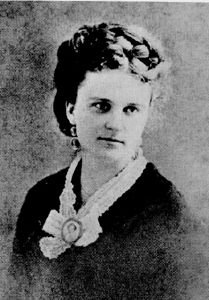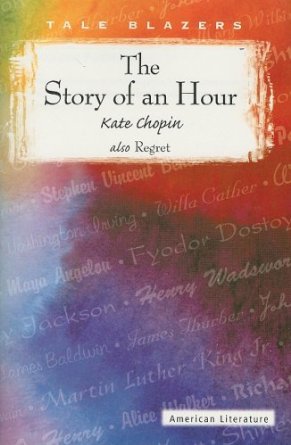
photo by Brian J. Matis
by Stephen Devereux
Kate Chopin is best known for her fin de siècle novel The Awakening. In the 1890s, however, she wrote short stories set amongst the French Americans of New Orleans and the Mississippi Delta.
These short stories were very popular, yet they also caused uproar amongst her readers. As she developed her art, her writing increasingly reflected her interest in the situation of women, particularly within marriage. Although The Awakening is widely read today and overshadows her output as a short story writer, her stories have a precision and deftness that the novel sometimes lacks.
Whilst all her stories are worth reading, ‘The Story of an Hour’ shows just how much can be achieved in under a thousand words. The opening sentence wastes no time on ‘setting the scene’ or ‘creating atmosphere’, but gets straight to the point:
Knowing that Mrs. Mallard was afflicted with heart trouble, great care was taken to break to her as gently as possible the news of her husband’s death.
We have all the facts at once. Or at least we think we do…
In the next paragraph, we discover that Mrs. Mallard’s sister and her husband’s close friend Richards have arrived ‘bearing the sad message’. We are told next that ‘She did not hear the story as many women have heard the same’. Chopin opens with the word ‘knowing’ and follows it with ‘news’, ‘message’ and ‘story’. On a second reading, we can see that these words are edged with irony.
Mrs. Mallard’s immediate reaction is to weep copiously, but the ‘storm of grief’ is ‘soon spent’. She locks herself in her room. Once she is alone, the language changes dramatically, shifting from the external facts to the woman’s innermost life. She  looks out of the window where the ‘trees were all aquiver with new spring life’. She notices sparrows twittering, someone singing, the cry of a street peddler and patches of blue sky. This doesn’t seem quite right. We are presented with symbols of new life rather than of death. By placing a woman alone, Chopin is able to present her outside the context of the society in which she plays a role. Chopin frequently gives her female characters ‘a room of one’s own’ and uses symbolism to convey the complex changes that are taking place in that solitude.
looks out of the window where the ‘trees were all aquiver with new spring life’. She notices sparrows twittering, someone singing, the cry of a street peddler and patches of blue sky. This doesn’t seem quite right. We are presented with symbols of new life rather than of death. By placing a woman alone, Chopin is able to present her outside the context of the society in which she plays a role. Chopin frequently gives her female characters ‘a room of one’s own’ and uses symbolism to convey the complex changes that are taking place in that solitude.
Given the brevity of the story, it is surprising that so much of it should be taken up with description of apparently irrelevant details. We are told once more about the patches of blue sky, then that Mrs. Mallard is young and fair. This is another surprise to the reader. We have imagined her as middle-aged. Had we known her age from the beginning, we would, perhaps, have read the story differently. As she gazes at the blue of the sky, she knows that ‘there was something coming to her…creeping out of the sky’.
Chopin often depicts women in a state of awareness of something which they struggle to name or identify; it an understanding that comes to them slowly and painfully. The word that forms on Mrs. Mallard’s lips and that she tries to suppress is ‘free’. She says it three times. It is not hard to guess how readers in the 1890s would have judged Mrs. Mallard.
As with Edna Pontelier’s husband in The Awakening, Mr. Mallard is not a bad man; he ‘had never looked save with love upon her’. It would weaken the story to present him as a stage villain. Marriage is a place where ‘men and women believe they have a right to impose a private will upon a fellow-creature’. Mrs Mallard realises that she has been freed from marriage, both from the burden of her husband’s will and from any need to impose her own. Her spirit quickens and lifts. She realises that has a life of her own to live once more: ‘She breathed a quick prayer that life might be long. It was only yesterday she had thought with a shudder that life might be long.’
At this point we learn that her sister, Josephine, is outside the locked door. We have been privy to Mrs. Mallard’s inner life, present at the birth of her transformed self. The woman locked out remains in the world of social realities. She begs her sister to open the door, thinking that she might harm herself or that her grief will overwhelm her without others to comfort her.
Chopin has called our protagonist ‘Mrs. Mallard’ throughout, to emphasise her role as a wife, and only now do we discover, through her sister’s urgent calling, that her name is Louise. She unlocks the door at last and descends the stairs, carrying herself ‘unwittingly like a goddess of Victory’. But, just at the moment she descends, someone opens the front door — her husband. It turns out that he was nowhere near the train crash in which he was reported as having died, nor has he even heard about it.
Mr. Mallard is very surprised at ‘Josephine’s piercing cry; at Richards’ quick motion to screen him from the view of his wife’. From Brently Mallard’s perspective his sister-in-law and his friend behave in a bizarre fashion.  Why does Richards try to shield him from his own wife? Brently Mallard cannot know of course that Richards came to help break the news of Brently’s own ostensible death; nor can he understand that Richards is now trying, with equivalent effort, to hide the fact that Brently Mallard is still alive. Louise’s heart condition is the reason, of course. Does the comic effect achieved here weaken the impact of the story? For me, it heightens it.
Why does Richards try to shield him from his own wife? Brently Mallard cannot know of course that Richards came to help break the news of Brently’s own ostensible death; nor can he understand that Richards is now trying, with equivalent effort, to hide the fact that Brently Mallard is still alive. Louise’s heart condition is the reason, of course. Does the comic effect achieved here weaken the impact of the story? For me, it heightens it.
The language switches back to the matter-of-fact tone of the opening. But there is a difference: now we know Louse’s innermost thoughts and her earlier, private moments of exultation. We are not told how Brently responds, nor are we told how Louise, having descended the stairs, reacts. But we can guess.
The story ends as it began with a one sentence paragraph: ‘When the doctors came they said she had died of heart disease – of joy that kills.’
The reader knows differently. Society must assure itself that the joy of discovering that her husband is not dead is what kills Louise. Yet we of course know that it is the sudden loss of freedom that kills her.
Divorce was not, of course, a socially acceptable option in this period. Like any other ‘decent’ married woman, Louise knew that only death could separate her from her husband. Ironically, in the end, it is her own death. What kills her is her fierce desire to live.
Once we share the secret of Mrs. Mallard’a inner life, the scene in which she looks out the window at the patch of blue sky is transformed in our minds. She knows that something is coming to her and she calls it freedom. It was, we know, her death. Those initial words – ‘news’, ‘message’ and ‘story’ – take on an ironic edge, for Louise believed that a message had come to her. Moreover, that first word – ‘knowing’ – is profoundly ironic, for each of the four characters believes he or she knows something, something which the reader knows is not true.
But Chopin has not deceived us. She never tells us that Mr. Mallard is dead, only that he has been ‘reported’ as dead. Richards hears this false news in a newspaper office. We are also made to consider what Louise’s life would have been had she never received this message. Her husband would have come through the door at exactly the same moment. She would have remained his wife. ‘She had loved him – sometimes.’ She would never have experienced that quickening of her spirit that was brought on by the news of her husband’s apparent death. Is that a good or bad thing? Chopin leaves us to decide.
‘The Story of an Hour’ takes three minutes to read.

